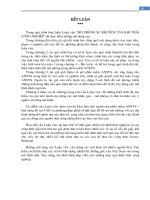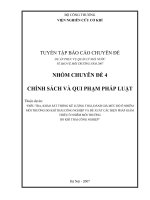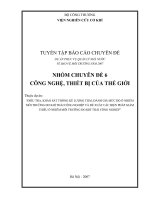Kẽm tích tụ ở địa y do khí thải công nghiệp khoảng Vorkuta, phía đông bắc châu Âu của Nga
Bạn đang xem bản rút gọn của tài liệu. Xem và tải ngay bản đầy đủ của tài liệu tại đây (189.87 KB, 10 trang )
vol. 29, no. 2, pp.
141–147, 2008
Zinc accumulation in lichens due to industrial emissions
around Vorkuta, northeast European Russia
Tony R. WALKER
School of Biology, University of Nottingham, Nottingham, NG7 2RD, UK;
Dillon Consulting Limited, 137 Chain Lake Drive, Halifax, Nova Scotia, B3S 1B3, Canada
<>
Abstract: Zinc concentrations in apices [Zn
2+
]
apex
of the lichens, Cladonia arbuscula and
C. rangiferina were determined along transects through two
sub−Arctic
towns in the Usa
River Basin, northeast European Russia. One transect, which was 130 km long running in
an
east−west
direction, passed through the town of Vorkuta and the other transect, which
was 240 km long running in a
southwest−northeast
direction, passed through Inta. Zinc ac
−
cumulation in lichens, which was detected 25–40 km within the vicinity of Vorkuta, was
largely attributed to local emissions of alkaline coal ash from coal combustion. The present
results using C. arbuscula around Vorkuta are consistent with those of previous studies
sug−
gesting that this lichen is a useful bioindicator for trace metals. There was no such
elevation of [Zn
2+
]
apex
detected in C. rangiferina along the transect running through Inta.
K e y w o
r
d s : Arctic, atmospheric deposition, zinc, lichens,
bioindicators,
Cladonia
arbus
−
cula, Cladonia rangiferina.
Introduction
Russia is the principal contributor of metal emissions in Europe and has the
most extensive industrial developments north of the Arctic Circle including the
mining and metallurgical industries of Norilsk in Siberia and Monchegorsk on
the Kola Peninsula (Toutoubalina and Rees 1999; Reimann et al. 2000). By
compari
−
son, north−eastern European Russia has suffered less from industrial
pollution and large areas remain unpolluted, although some locations bear the
signs of local en
−
vironmental degradation, such as changes in community
structure of vegetation around the coal mining town of Vorkuta (Virtanen et al.
2002). Exploitation of coal here began in the 1930s and intensified until the
1990s when extraction de
−
clined owing to
increased
transportation costs and
poor combustion qualities of the coal (Hill 2000). Vorkuta is the centre of the
coal industry with six mines operating during the period of this research in 1999
whereas Inta had fewer operating mines
Pol. Polar
Res.
29 (2):
141–147, 2008
142 Tony R. Walker
in 1998 and a comparatively smaller coal mining industry. Coal mining and com
−
bustion for power
generation
have been the principal sources of heavy metal
pollu
−
tion in the region; with Vorkuta being the highest emitter and suffering a
legacy of pollution impacts resulting from the deposition of alkaline fly ash
(Solovieva et al.
2002; Walker et al. 2003a, b; Walker 2005). An inventory of pollutants emitted
from both towns has been summarized by Solovieva et al. (2002).
Mat−forming
terricolous lichens are important components of plant
communi
−
ties in high latitudes, where they contribute to nutrient cycling and
secondary
pro
−
duction, such as grazing (Longton 1997). Lichens are primarily
dependant on at
−
mospheric
sources
for
nutrients and therefore readily
accumulate atmospheric contaminants, such as metals (Nash and Gries 1995).
Therefore, they are amongst the most pollution sensitive receptors in terrestrial
ecosystems (Richardson 1988). Spatial variation in the chemical composition of
lichens has been widely used to monitor environmental quality as a result of
industrial activities including situated around
coal−fired
power stations (Gonzalez
and Pignata 1997; Walker and Pystina
2006; Walker et al. 2006a). The principle source of electrical power used in the
town in this study is generated by
coal−fired
power stations.
The present research aimed at assessing the extent of zinc deposition due to
lo−
cal sources around Vorkuta and Inta in the Komi Republic, northeast
European Russia using the lichens Cladonia arbuscula and C. rangiferina along
a transect passing
through
both towns. This region spans the
sub−Arctic
taiga
forest and tun
−
dra ecotones and has already been identified as a significant
source of metal
emis−
sions mainly as a result of coal fired power stations in the
towns of Vorkuta and to a lesser extent Inta (Solovieva et al. 2002; Walker et al.
2003a, b; Walker 2005; Walker et al. 2006b). The study provided an opportunity
to further evaluate the use of terricolous lichens as bioindicators of metal
deposition (Walker et al. 2003b,
2006a).
Materials and methods
Transect
s for samp
ling lichens were establishe
d that pass
ed
through
the
towns
of
Vorkuta (67 30’N, 64 05’E) and through Inta (66 03’N, 60 10’E). Inta
was chosen for the second transect study because it also has a large coal industry
and is currently the second most largest coal
producing
town in the region. These
sampling locations and transects have been illustrated and described in greater
detail elsewhere (see Fig. 1; Walker et al. 2003a, b). The transect passing through
Vorkuta was
approxi
−
mately 130 km long and oriented
west−east;
characterized
by Betula nana L. shrub tundra along its
entire
length. The transect passing
through Inta
was 240 km long and oriented
southwest−northeast
spanning taiga
forest
and tundra ecotones. Mean an
−
nual precipitation for Vorkuta and Inta is
518 and 473 mm respectively and south westerly winds prevail in the region.
Zinc accumulation in lichens 143
Fig. 1. Pechora region showing sampling transects through the towns of Vorkuta and
Inta.
Six sampling sites were selected along each of the transects. Originally nine
sampling sites had been chosen along the Inta transect (reflecting its greater
length) but the availability of C. rangiferina along this transect was limited partly
due to the lack of suitable lichen heath habitat in the area. At each site, three
sub−sites
were selected, 1 km apart, at which six replicate samples of lichen were
collected at distances 10–20 m apart in open areas in order to minimize tree
canopy effects; these were usually inter−tree positions in open forest, or in
tundra. Most sites were in wilderness areas remote from roads. Terricolous
mat−forming
lichens C. arbuscula (Wallr.) Flot. and C. rangiferina (L.)
F.H.Wigg. were collected at
sub−sites
to provide biomarkers for atmospheric
deposition and because of their abundance in shrub tundra and taiga forest.
Lichen
samples were
air−dried
in the field, sealed in LDPE containers and
stored at 4 C until analysis.
Powder−free
LDPE gloves were worn when
handling lichens in the field and the laboratory to minimise contamination.
Lichens were
rehydra
t
ed overnight by exposure to wa
−
ter−saturated
air (over
water in a desiccator) at 4 C, then fully saturated by
spray
−
ing lightly with
deionised water an
d cleaned of extraneous debris using forceps. Samples were
dried overnight at 80 C and then weighed, where c. 100 mg of api
cal (5 mm)
tissue was digested to dryness in 1 mL of concentrated HNO
3
at 175 C. The
residue was dissolved in 10 mL 1 M HNO
3
and
appropriate
quantities of ionis
−
ation
suppressant
and
releasing
agent (CsC1
2
, LaC1
2
) added. Zinc was selected
be
−
cause it was one of several trace metals found to contaminate snow and soils
lo
−
apex
144 Tony R. Walker
cally in the survey region (see Walker et al. 2003a; Walker 2005) and was mea
−
sured by flame atomic absorption spectrophotometry (FAAS); concentrations
were
recalculated
in relation to the mass of dried apical lichen tissue to allow
direct comparison with the solution data (see Walker et al. 2003b).
Genstat and Minitab were used to perform standard statistical analyses
(ANOVA, correlation analysis and linear regression).
Results and discussion
Collections of C. arbuscula was complete at all six sites along the Vorkuta
transect
despite
mat−forming
lichen cover being generally poor in the region due
to heavy grazing and trampling by reindeer (Crittenden 2000). Along the
Inta transect collections of C. rangiferina were made as C. arbuscula was less
abun
−
dant along this transect. Whilst no attempt was made to compare absolute
concen
−
trations between the two lichen species they were chosen based on their
availabil
−
ity along each transect. Therefore the results of this study may be used
as a proxy for indicating localized perturbations of Zn concentrations. There was
significant localized higher [Zn
2+
]
apex
in C. arbuscula in the vicinity of Vorkuta
(P <0.001). For example the highest concentration of [Zn
2+
]
apex
in C. arbuscula
were found at the two sites closest to the town (see Fig. 2a). Previous studies
found no such local
−
ized elevated concentrations in [Zn
2+
]
apex
in C. stellaris
around Inta, but it was strongly related to latitude (Walker et al. 2003b). It is
possible that the apparent lack of any Zn perturbation around Inta may be due
to lower sampling density
Comparison of [Zn
2+
]
Tabl e 1
(μg g
−1
)
in Cladonia spp. from high latitude industrial and
pristine
areas. Grey shading indicates industrial areas
Location Species
[Zn]
(μg g
−1
)
Study
Vorkuta (Transect) (coal mining) C. arbuscula 16–55 This study
Inta, NE European Russia (coal mining) C. rangiferina 15–34 This study
Inta, NE European Russia (coal mining) C. stellaris 9–32 Walker et al. (2003b)
Gusum, Sweden (steel foundry) C. rangiferina 55–75
Folkeson and
Andersson−Bringmark
(1988)
SE Ohio, USA (coal mining) Cladonia sp. 27–42 Lawrey and Rudolf
(1975)
Ontario, Canada, Uranium mines
(0.5–30 km)
C. mitis 13–22 Fahselt et al. (1995)
Delaware Gap, USA (zinc smelter) Cladonia sp. 61–80 Nash (1975)
Northwest Territories, Canada Cladonia sp. 7–55 Puckett (1978)
Northwest Territories, Canada Cladonia sp. 16–25 Puckett and Finegan (1980)
Bellsund area, Spitsbergen Cladonia sp. 29–39 Jóźwik (1990)
High Point Park, New Jersey, USA C. rangiferina 7–16 Glenn et al. (1991)









